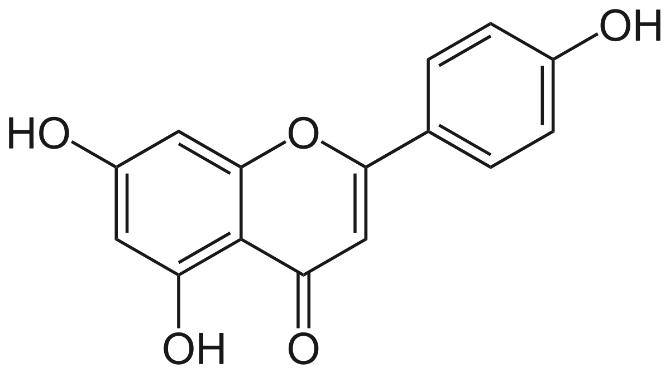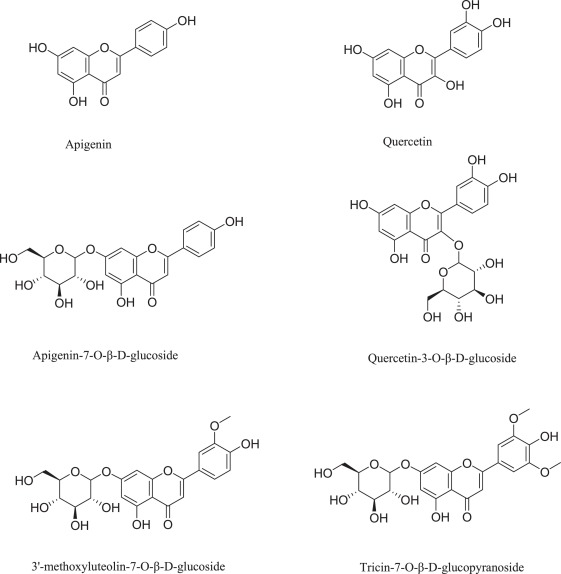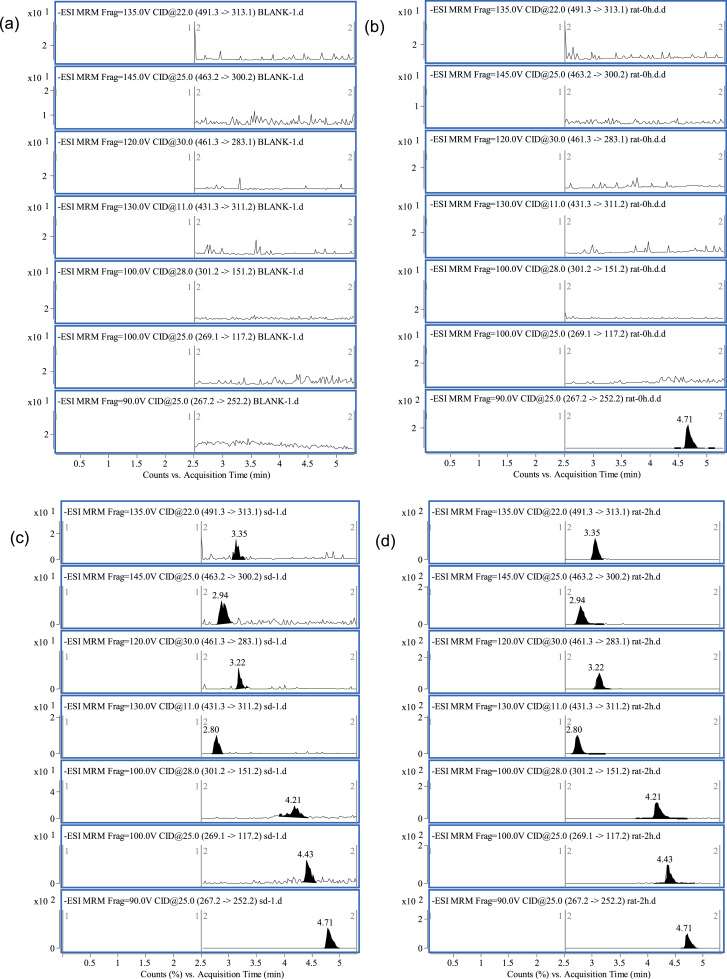What is Apigenin?
Apigenin, often touted as the "champion" of flavonoids, is a naturally abundant dietary phytochemical that has been studied extensively for its potent anti-carcinogenic, anti-inflammatory, and antioxidant activities. This remarkable bioactive compound is found largely in fruits such as oranges and grapefruits, and in plants like parsley and chamomile. In the realm of biological science, apigenin is recognized as more than just a simple plant metabolite; it is known for its significant contributions to human health and wellness, and its potential therapeutic value in the treatment and prevention of various diseases.
From a molecular viewpoint, apigenin (C15H10O5) is a yellow crystalline solid and a member of the flavones, a particular cohort of flavonoids recognized by the position of the phenyl group on the heterocyclic cinnamoyl system. Apigenin possesses a unique chemical structure that allows it to assertively interact with multiple cellular targets and evoke a broad range of biological responses.
 Apigenin
Apigenin
Creative Proteomics offers apigenin analysis platforms. Our services provide scientific quantitative analysis of the presence and concentration of flavonoids in a wide variety of foods and plant extracts, assessing the quality, nutritional value, and potential health benefits of various foods. Additionally, we can provide bioavailability analysis reports for apigenin.
Our platform helps to identify subtle differences in the structural conformation of apigenin and its metabolites helps to unravel the molecular mechanism of its bioactive action and facilitates the development of novel therapeutic strategies for diseases such as cancer, cardiovascular diseases and neurodegenerative diseases.
Apigenin is an important candidate for use in food additives and nutraceutical formulations, and we help in quantitative and qualitative evaluations to ensure product compliance and safety.
Specific Apigenin Analysis Offered by Creative Proteomics
At Creative Proteomics, our apigenin analysis projects are meticulously designed to unravel the complexities of this intriguing flavonoid. The primary objectives of our apigenin analysis projects include:
- Structural Elucidation: Comprehensive characterization of apigenin and its derivatives to understand their molecular structures.
- Quantitative Analysis: Accurate determination of apigenin concentrations in various sample types, providing crucial data for research and development.
- Identification of Derivatives: Detection and identification of apigenin derivatives, expanding the scope of our analysis.
- Sample Specificity: Tailoring our analysis to diverse sample types, including plant extracts, biological fluids, and tissue samples.
Apigenin Analysis Techniques
Liquid Chromatography-Mass Spectrometry (LC-MS/MS)
- LC System: Employs a robust liquid chromatography system for efficient separation.
- Triple Quadrupole Mass Spectrometer: Recognized for its exceptional sensitivity and accurate mass measurement, crucial for Apigenin analysis.
Advantages:
- Exceptional Sensitivity: The Triple Quadrupole Mass Spectrometer offers an impressive sensitivity, capable of detecting Apigenin and its derivatives at concentrations as low as 1 picogram per milliliter (1 pg/mL).
- Accurate Quantification: With a dynamic range spanning six orders of magnitude, the instrument ensures accurate quantification across a wide range of Apigenin concentrations, from trace levels to high concentrations.
- Rapid Data Acquisition: The high-speed data acquisition capability of the LC-MS/MS system allows for the analysis of a large number of samples in a short timeframe, promoting efficiency and throughput.
Gas Chromatography-Mass Spectrometry (GC-MS)
- GC System: Our gas chromatography system, featuring the Model GC-7890B, excels in the separation of volatile compounds. It plays a crucial role in the analysis of apigenin and its derivatives.
- Mass Spectrometer: The mass spectrometry component, Model MSD-5977A, contributes to sensitive detection and precise identification of compounds in the gaseous state.
Advantages:
- Efficient Separation: The GC-7890B ensures precise separation of volatile compounds, crucial for accurate analysis of Apigenin derivatives.
- High Sensitivity: The MSD-5977A Mass Spectrometer offers high sensitivity, enabling detection of Apigenin and derivatives at concentrations as low as 0.1 nanograms per microliter (0.1 ng/μL), especially beneficial for trace-level compounds.
- Wide Dynamic Range: Accommodating a broad spectrum of compound concentrations in a single analysis, the MSD-5977A eliminates the need for multiple sample injections.
- Rapid Analysis: The GC system's quick temperature ramping contributes to swift sample analysis, enhancing overall laboratory productivity.
 Workflow for Plant Metabolomics Service
Workflow for Plant Metabolomics Service
List of Apigenin and Its Derivatives Analyzed (including but not limited to)
| Apigenin |
Apigenin-7-O-glucoside |
Apigenin-7-O-rutinoside |
Apigenin-8-C-glucoside |
| Apigenin-6-C-arabinoside |
Apigenin-6,8-di-C-glucoside |
Apigeninidin |
Vitexin |
| Isovitexin |
Luteolin |
Quercetin |
Chrysin |
Sample Requirements for Apigenin Assay
| Sample Type |
Recommended Quantity |
| Plant tissues |
>100 |
| Blood |
1-2 mL |
| Cerebrospinal fluid |
0.5-1 mL |
| Urine |
5-10 mL |
| Feces |
>100 |
| Other tissues |
>100 |
Deliverables from Apigenin Analysis
Upon conclusion of the apigenin analysis, Creative Proteomics provides:
- A comprehensive report containing:
Experimental procedure
Parameters of liquid chromatography and mass spectrometer
MS/MS spectral results for peak identification
Bioinformatics analysis
- Raw data and analyzed data
- Interpretation and summary of results
Case. Development and Application of LC–MS/MS Method for Simultaneous Determination of Six Flavonoids in Rat Plasma
Background
Paulownia tomentosa Steud. is traditionally used for treating infectious diseases. This study focuses on the pharmacokinetics of its bioactive flavonoids, known for various health benefits. The aim is to develop a robust LC–MS/MS method for their simultaneous determination in rat plasma following oral administration of P. tomentosa flower extract.
Sample
Flowers were collected in Anhui, China, and identified as P. tomentosa. The P. tomentosa flower extract was prepared using a 70% ethanol extraction method. The administered dose was determined by quantifying six constituents in the extract. Rat plasma samples were used for the pharmacokinetic study.
Technical Platform and Procedure
1. Chromatographic Conditions:
- HPLC system: Agilent 1200 series.
- Column: ZORBAX SB-Aq (5 μm; 150 mm × 4.6 mm) with a Security-Guard C18 (5 μm; 4.6 mm × 3 mm).
- Gradient elution with 2 mM aqueous ammonium acetate (eluents A) and acetonitrile (eluents B).
- Flow rate: 0.9 mL/min, split ratio 2:1, total run time 10.5 min.
2. Mass Spectrometric Conditions:
- Agilent 6460 triple–quadrupole mass spectrometer with ESI in negative ion mode.
- Selected ion transitions for six flavonoids and internal standard (IS).
3. Preparation of P. tomentosa Flower Extract:
- Flowers soaked twice in 70% ethanol at 80 °C.
- Extract concentrated and quantified for the six constituents.
4. Preparation of Standard and QC Samples:
- Mixed stock solutions of standards and IS prepared in methanol.
- Calibration curves and QC samples prepared in rat plasma.
5. Sample Preparation:
- Liquid–liquid extraction method used.
- Rat plasma mixed with IS, hydrochloric acid, and extracted with dichloromethane.
- Extract evaporated, reconstituted, and injected into LC–MS/MS.
 The chemical structures of six flavonoids.
The chemical structures of six flavonoids.
Results
Method Validation:
- Selectivity confirmed with blank plasma samples.
- Calibration curves exhibited good linearity (r > 0.995).
- Sensitivity with LLOD and LLOQ suitable for pharmacokinetic studies.
- Precision and accuracy within acceptable limits.
- Extraction recovery >85%, matrix effect between 86.7% and 103.4%.
- Stability of analytes in rat plasma during processing and storage.
Pharmacokinetic Study:
- Application of the validated LC–MS/MS method to determine six flavonoids in rat plasma.
- Successful detection of drug concentration up to 24 h post oral administration.
- Main pharmacokinetic parameters calculated using non-compartmental analysis.
 Representative MRM chromatograms of six flavonoids and IS in plasma.
Representative MRM chromatograms of six flavonoids and IS in plasma.
Reference
- Dai, Bin, et al. "Simultaneous determination of six flavonoids from Paulownia tomentosa flower extract in rat plasma by LC–MS/MS and its application to a pharmacokinetic study." Journal of Chromatography B 978 (2015): 54-61.


 Apigenin
Apigenin Workflow for Plant Metabolomics Service
Workflow for Plant Metabolomics Service The chemical structures of six flavonoids.
The chemical structures of six flavonoids. Representative MRM chromatograms of six flavonoids and IS in plasma.
Representative MRM chromatograms of six flavonoids and IS in plasma.